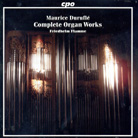September 2004
 Maurice Duruflé is known to legions of music lovers for his
colorful and conciliatory Requiem, a composition skillfully scored for various
combinations of instruments, so that both amateur and professional choral ensembles might
perform it. The composer’s love and knowledge of Gregorian chant is evident in that
work, as it is in almost all of his music. Duruflé did not write much music for solo
organ, yet his compositions for the instrument are considered among the best of the 20th
century. Maurice Duruflé is known to legions of music lovers for his
colorful and conciliatory Requiem, a composition skillfully scored for various
combinations of instruments, so that both amateur and professional choral ensembles might
perform it. The composer’s love and knowledge of Gregorian chant is evident in that
work, as it is in almost all of his music. Duruflé did not write much music for solo
organ, yet his compositions for the instrument are considered among the best of the 20th
century.
With the exception of the quiet, gentle Chant Donné and Méditation, this music is far more challenging than that of the Requiem, for both player and listener. The compositions were written with the virtuoso soloist in mind, and are more astringent, even dissonant, than his choral works. The Toccata, which closes out the opus 5 Suite is almost frightening, with its repeated chords hammered against swirling figures. Hearing it live, one might fear the collapse of a cathedral ceiling! A description of the works is included in the excellent booklet that accompanies the SACD, so I will not dwell on that. I will discuss the sound, which is the most impressive I have heard in recording the "King of Instruments." The organ this time is a new one, having been inaugurated in 2000. It was built by Mühleisen, and is situated in the Church of St. Anastasius and St. Innocentius in Lower Saxony. The colorful instrument has been given pipes that are appropriate for both Baroque clarity and Romantic expressiveness. Soloist Friedhelm Flamme proves himself a genuine virtuoso. He tosses off difficult passages as so much child’s play. Flamme never lets technique get in the way of meaning, however. He is very sensitive to the lyrical aspects of this music and also knows how to register his instrument to best effect. I would say he is the ideal soloist for this repertory. The recording causes one to feel that he is actually in the acoustic space that houses the magnificent instrument. Note that I did not say that he is hearing a recording of the space. It sounds like the actual space must sound. When I close my eyes, my listening room disappears and I might very well be in the church where this recording was made. This effect is due to two things. The advanced-resolution format allows for ultimate realism of sound, with every pipe and pipe doubling clean and clear. Careful use of the surrounds preserves the sense of air in motion that one "feels" in a performance of this sort. The long decay of sound is also caught accurately, without any more intrusion on the primary sounds than would be heard in a live situation. The center channel helps anchor everything in place. You can walk around your listening room, and it is much like walking around an actual church while listening to the music. This recording is a prime example of what multichannel sound, properly employed, can do to create a more realistic listening experience at home. The advanced-resolution stereo tracks are good, and they are included for those who do not have multichannel playback capability, as are CD tracks for those not able to play SACD at all. But having this recording in one’s collection seems reason enough to take the plunge into full multichannel sound. The rewards are that great. GO BACK TO: |
 Duruflé -
Complete Organ Works
Duruflé -
Complete Organ Works